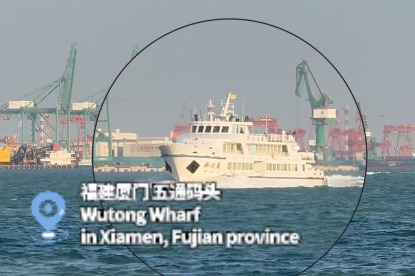China and the World in the New Era
China Daily | Updated: 2019-09-28 10:27
II. China's Development Is an Opportunity for the World
With the rapid increase of China's comprehensive national strength and international influence, some people worry that China will fulfill the outdated expectation that a country will invariably seek hegemony when it grows strong, so they have created what they call the "China threat" theory. The causes of this theory include cognitive misunderstanding, deep-rooted prejudice, a psychological imbalance brought about by the prospect of falling power, and deliberate distortions by vested interests. To realize national prosperity, rejuvenation, and people's happiness is a dream shared by the Chinese with peoples of other countries. Rather than a threat or challenge, China's development is an opportunity for the world.
1. China is the main stabilizing force and power source of the world economy
From 1979 to 2018 China's economy grew rapidly at an average annual rate of 9.4 percent, and became an important engine of global economic growth. In 2008, the world suffered a serious financial crisis and the world economy was hit hard. Through a series of effective measures to deal with the crisis, China's economy recovered rapidly and continued to maintain a medium-and high-speed growth. As a result, China became the main stabilizing force and power source of the world economy.
China is the biggest contributor to world economic growth. Since the 18th CPC National Congress in 2012, China has implemented the concepts of innovative, coordinated, green, open and inclusive development. It has adapted to, steered, and led the new normal of economic development, strengthened supply-side structural reform, and maintained a sustainable and healthy economic development with increasing quality and efficiency. In the past three years, China's economic aggregate has exceeded RMB70, 80, and 90 trillion successively, accounting for nearly 16 percent of the world economy. From 2013 to 2018, China contributed more than 28 percent of world economic growth on average. Estimates show that without China, the average annual growth rate of the world economy from 2013 to 2016 would have slowed by 0.6 percentage point and the intensity of fluctuation would have increased by 5.2 percent. According to a report released by the McKinsey Global Institute (MGI), the aggregate index of the world's exposure to China's economy gradually rose from 0.4 to 1.2 between 2000 and 2017, with China accounting for 35 percent of global manufacturing output.
China's scientific and technological innovations have injected new momentum into world economic growth. In recent years, investment in the field of science and technology in China has been increasing, and major scientific and technological innovations have emerged. In 2018, China's R&D spending accounted for 2.19 percent of GDP. According to the Global Innovation Index (GII) released by the World Intellectual Property Organization (WIPO) and other organizations, China continued its rise in 2019, moving from 17th in 2018 to 14th (see Box 5); it is the only middle-income economy in the top 20. In the field of high technology, China is catching up and getting ahead. Quantum communications, supercomputing, aerospace, artificial intelligence, fifth-generation mobile network technology (5G), mobile payment, new energy vehicles, high-speed rail, and financial technology are sectors in which China leads the world. China's innovations in science and technology have been widely applied, bringing more convenience to the work and daily life of people of other countries, and injecting new momentum into world economic growth.
Box 5 International Organizations and Foreign Institutions Make Positive Comments on China's Scientific and Technological Innovation
According to the 2019 GII report issued by WIPO and others, the Bloomberg New Economy Forum Survey, and the KPMG Technology Industry Innovation Survey, China continues to improve its global ranking in innovation.
First, China's capability in innovation has continuously improved. China's GII has risen for four years in a row, moving to 14th this year and being the only middle-income economy in the top 20, according to the GII report.
Second, China's science and technology clusters are rising collectively. Eighteen science and technology clusters in China are among the top 100 in the world, an increase of two over last year. This is second only to the United States, which has 26 clusters in the top 100. Among them, the Shenzhen-Hong Kong cluster ranks second and the Beijing cluster ranks fourth. The rankings of almost all Chinese clusters are on the rise compared with last year. According to a Bloomberg survey of global business professionals, 39 percent of respondents believe that Beijing will become the world's top tech city by 2035, and 26 percent believe that Shanghai will become the world's center of technological innovation in the future.
Third, the quality of innovation in China has further improved. The GII report points out that the focus of current global competition for innovation has shifted from quantity to quality. China ranks 15th in terms of innovation quality, and has ranked first among middle-income economies for the past seven years. It is also the only middle-income economy that has narrowed the gap with high-income economies in terms of the quality of universities, internationalization of local inventions, and the quality of scientific publications, measured by the number of citations that locally produced research documents receive abroad. The quality of Chinese universities ranks third only to the United States and the United Kingdom. China ranks first among the middle-income economies in international patents and the quality of scientific publications. Its innovation input-output performance is close to or higher than that of some high-income economies, and it is on a par with Germany, the UK, Finland, Israel and the US in terms of innovation output. China's industrial designs, trademark applications, and exports of high-tech and creative products are surging ahead. The number of patent applications for inventions in China has soared from 10,000 in 1990 to 1.38 million in 2017.
























